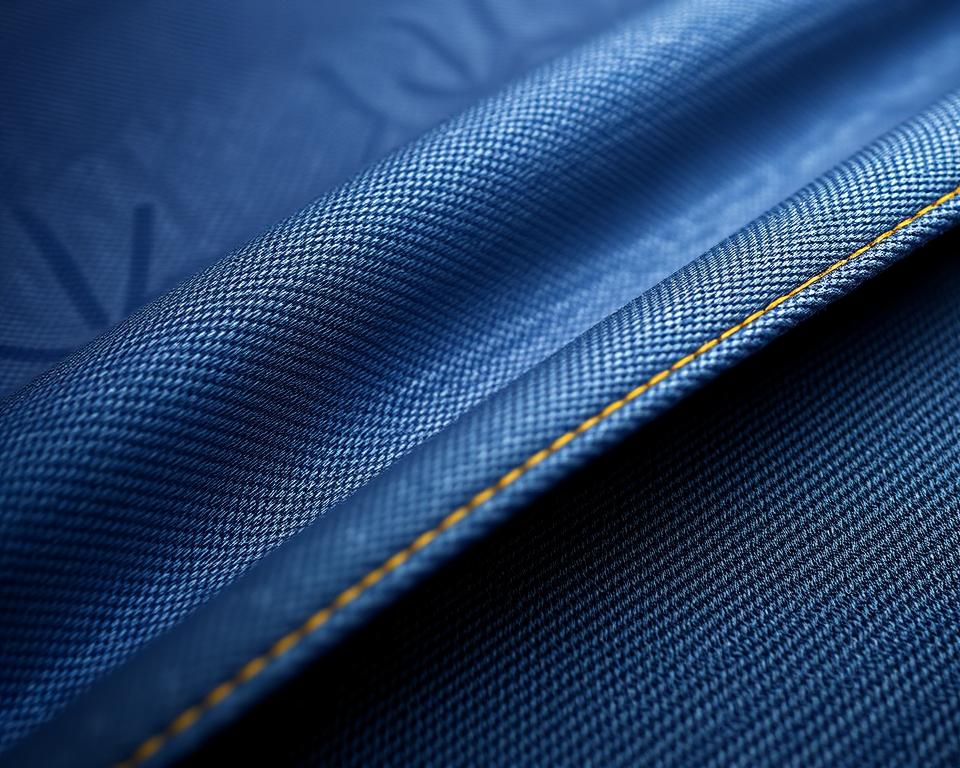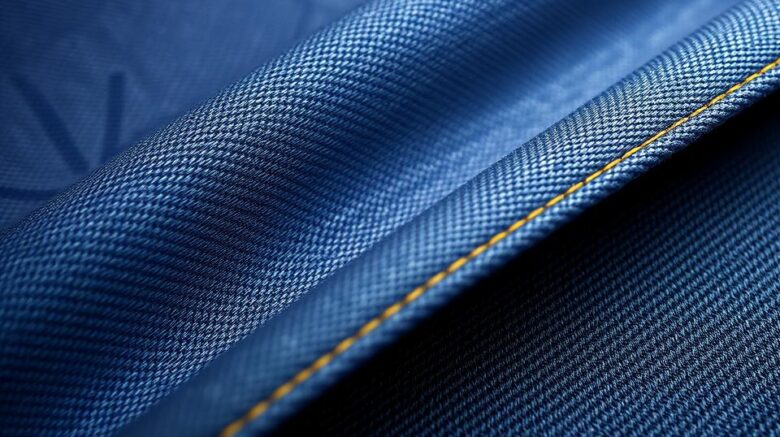A Comprehensive Guide to Superior denim Selvedge Fabric
Ever questioned the reason some jeans seem like they’re designed for longevity a lifetime? It’s all about the materials and artistry. Consider the growing popularity of premium selvedge. It’s not merely ordinary fabric—it attests to quality and legacy.
Currently, increasingly more individuals are opting for these timeless fabrics for their sturdiness and traditional selvedge denim fabric charm. Be it that you are a home sewing sewist or a denim aficionado, there’s something special about working with top-grade natural fiber and thread. It’s not just about creating trousers; it’s about fashioning something that tells a story.
Within Core Fabrics, we’ve curated a collection of 14.25oz eco-friendly cotton and stretch choices. These materials are tailor-made for everything from raw jeans to designer jacket designs. Eager to discover the world of top-tier fabrics? Let us delve in.
Understanding Denim Selvedge Fabric?
Why do particular trousers stand out with their distinctive, finished without extra steps edges? The key is found in the selvedge denim, a superior textile known for its enduring strength and retro aesthetic. Unlike regular textiles, this type of fabric is produced using traditional methods that have proven their worth.
What Selvedge Denim Means
Selvedge denim is produced with old-style shuttle looms, which generate narrow widths of about 30-35 inches. These looms weave the material in a method that delivers self-finished seams, often accented with a signature red line. This process ensures the textile is tightly woven and highly durable.
Current looms, in contrast, produce broader textile but fall short of the same level of craftsmanship. Minor flaws in selvedge, like leg twists or inconsistent patterns, are celebrated as elements of its beauty. This philosophy, termed “wabi-sabi”, celebrates the appeal of organic flaws.
How Selvedge Denim Is Made
The production of selvedge denim entails a exacting process. Shuttle looms interlace the weft thread alternately, resulting in a thick and resilient material. This process stands in contrast with new-age looms, which prioritize quick production and efficiency over durability.
Brands like Karson Denim maintain vintage Japanese weaving techniques from the 1990s. They intentionally include anomalies to retain the genuineness of the textile. Each piece is assessed on a four-point system, ensuring it meets the highest standards of superiority.
| Characteristic | Selvedge Denim | Current Denim |
|---|---|---|
| Width | 30-35 inches | 60+ inches |
| Construction Technique | Classic Shuttle Loom | Contemporary Loom |
| Texture | Uneven, Imperfect | Uniform |
| Durability | Exceptional | Average |
“The allure of selvedge is found in its flaws—each irregularity speaks of skill and legacy.”
The History of Selvedge Denim
Evolving from simple roots to international fame, the narrative of these materials is rich and moving. Originally developed as durable workwear in the 17th-century France evolved into a mark of timeless style and excellence.
Origins in Traditional Weaving
The roots of this textile reaches back to Nîmes, France, where it was known as “serge de Nîmes.” Originally designed for laborers, it was constructed with robust cotton and stitching. Its durability ensured its popularity among laborers during the Gold Rush.
By the 20th century, it had evolved into a staple for pants. The shuttering of the Cone Mills White Oak facility served as a catalyst. This change paved the way for Japanese artisans to revive old-world weaving methods.

Modern Developments in Denim
Following WWII, Japan developed a deep appreciation for retro American culture. Skilled workers restored old looms to manufacture true reproductions. This devotion to quality guaranteed the continuance of selvedge as a niche product.
Currently, innovations from Italy and Turkey have launched sustainable combinations and flexible options. These advancements have enhanced the allure of this classic material. Within Core Fabrics, we gather worldwide, from Montréal to Asia, to offer you the top-notch standards.
“The legacy of selvedge is a tribute to the enduring value of excellence and heritage.”
The Benefits of Selvedge Denim?
What makes selvedge denim shine in the realm of superior textiles? Its special characteristics and exceptional longevity make it a favorite among aficionados and creatives alike. Whether you’re sewing jeans or a tailored jacket, this textile provides a fusion of classic methods and modern appeal.
Unique Qualities of Selvedge Fabric
Selvedge denim is renowned for its firm interlacing, which improves durability and color fading characteristics. In contrast to common fabrics, selvedge denim material is fashioned using traditional shuttle looms, yielding a more compact and exceptionally sturdy fabric. This process ensures that each piece has a singular finish and personality.
Notable attributes are:
- Coarse, stiff raw denim juxtaposes against softened, pre-washed stretch fabrics.
- Through sanforization, sizes become reliable, while untreated fabrics provide a shrink-to-fit adventure.
- Available weights span from 9.5oz Eco Finish to 14.25oz Organic, suited for varied requirements.
Sturdiness and Lifespan
One of the standout features of selvedge denim is its enduring nature. The firm interlacing both reinforces strength and permits characteristic wear patterns over time. This renders it a valuable investment for those seeking enduring style.
Main considerations:
- Mid-weight fabrics from 12oz to 14oz work well for tailored jackets and evolving jeans.
- The 14.25oz True Indigo option is highly favored for enduring jeans.
- Sustainable variants such as recycled cotton combined with indigo blends enhance eco-friendliness.
At Core Fabrics, our collection includes a variety of options to suit your needs. Spanning from raw finishes to sanforized treatments, each selection is designed for superior quality and value.
Selvedge vs. Wide Denim: A Comparison
When it comes to crafting robust and fashionable apparel, the decision of material matters significantly. Two common choices include selvedge and wide denim, both offering different features. Knowing how they differ assists in selecting the ideal material for your project.
Key Differences in Weaving Techniques
Selvedge denim is woven on time-honored shuttle looms, yielding slim widths of 30-35 inches. This striped selvedge denim fabric method generates firm borders, often accented with a distinctive red line. Conversely, wide denim employs advanced projectile looms, resulting in widths of 60 inches or more.
Shuttle looms are slower, producing about 3 meters per minute, while modern projectile looms reach speeds of 30 meters per minute. The variance in production speed affects both the cost and the texture of the final product.
Pros and Cons of Each Type
Selvedge denim is celebrated for its superior quality and strength. Its limited breadth makes it ideal for applications where defined edges and detail work are sought. However, it can be pricier, typically around $23 per meter.
Wide denim is budget-friendly, typically costing $8 per half-meter. Its expansive dimension reduces waste, ideal for large projects like furniture covering. However, it does not feature the unique edge finish of selvedge.
| Characteristic | Selvedge Denim | Wide Denim |
|---|---|---|
| Width | 30-35 inches | 60+ inches |
| Method | Traditional Shuttle | Modern Projectile |
| Rate | 3m/min | 30 meters per minute |
| Price | $23/meter | $8/half-meter |
For structured edges, like those needed in Grainline Thayer jackets, selvedge is the preferred choice. Conversely, wide denim is ideal for extensive projects due to its efficiency. Evaluate your project specifications to choose wisely.
Working with Selvedge Denim
Utilizing superior fabrics can transform your sewing endeavors. Be it making trousers, blazers, or skirts, knowing how to measure, sew, and care for the material secures expert outcomes. Let’s explore how to make the most of this timeless material.
Yardage Needed for Jeans and Jackets
When planning your project, calculating the right amount of material is crucial. For men’s jeans, you’ll need about 3-3.3 yards, accounting for potential defects and shrinkage. Trucker-style jackets generally demand about 3.3 yards, while a skirt often needs 2 yards.
Smart pattern positioning minimizes the impact of defects. Instead of cutting around defects, consider integrating them into your design for a unique look.
| Garment | Fabric Needed |
|---|---|
| Male Jeans | 3–3.3 yards |
| Trucker-Style Jacket | 3.3 yards |
| Dress | 2 yards |
Tips for Sewing and Care
Employing proper equipment and methods leads to an impeccable finish. Opt for #70-110 pins and machine attachments made for robust textiles. Gütermann rPET thread works well for contrasting stitches.
Additional advice includes:
- A tailor’s clapper helps deliver defined creases without unwanted shine.
- Our denim kits from Core Fabrics comprise topstitch thread, rivets, and 9mm jeans buttons to ensure a refined result.
- For structured edges, like those in jackets, selvedge is the preferred choice.
Proper care extends the life of your creations. Wash sparingly and air dry to maintain the material’s integrity. With these tips, your projects will stand the test of time.
Conclusion
Crafting with premium materials isn’t just about durability—it’s about creating something with character. Selvedge denim exemplifies this principle, fusing craftsman allure with long-lasting quality. From jeans to tailored jackets, every stitch of this material conveys a narrative.
With Core Fabrics, unleashing your creative potential is effortless. Experience our swatch service to gauge texture and weight prior to purchase. Additionally, benefit from complimentary shipping on orders exceeding $150 USD throughout North America.
Looking ahead, eco-friendly blends and vintage washes are shaping the future of cotton textiles. These trends offer new ways to add sustainability and style to your wardrobe.
Eager to explore top-tier textiles? Begin your journey now and appreciate the merit of intentional crafting. Your next project could be a timeless piece that lasts for years to come.
